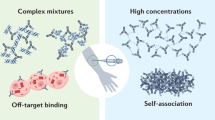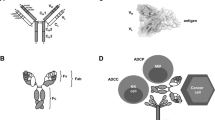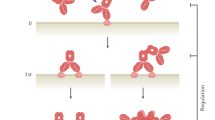Abstract
The combination of technological advances, genomic sequences and market success is catalyzing rapid development of antibody-based therapeutics. Cell surface receptors and ion channel proteins are well known drug targets, but the latter has seen less success. The availability of crystal structures, better understanding of gating biophysics and validation of physiological roles now form an excellent foundation to pursue antibody-based therapeutics targeting ion channels to treat a variety of diseases.
Similar content being viewed by others
Log in or create a free account to read this content
Gain free access to this article, as well as selected content from this journal and more on nature.com
or
References
Vernino S . Autoimmune and paraneoplastic channelopathies. Neurotherapeutics 2007; 4: 305–14.
Vincent A, Lang B, Newsom-Davis J . Autoimmunity to the voltage-gated calcium channel underlies the Lambert-Eaton myasthenic syndrome, a paraneoplastic disorder. Trends Neurosci 1989; 12: 496–502.
Pinto A, Gillard S, Moss F, Whyte K, Brust P, Williams M, et al. Human autoantibodies specific for the α1A calcium channel subunit reduce both P-type and Q-type calcium currents in cerebellar neurons. Proc Natl Acad Sci U S A 1998; 95: 8328–33.
Shillito P, Molenaar PC, Vincent A, Leys K, Zheng W, van den Berg RJ, et al. Acquired neuromyotonia: Evidence for autoantibodies directed against K+ channels of peripheral nerves. Ann Neurol 1995; 38: 714–22.
Tomimitsu H, Arimura K, Nagado T, Watanabe O, Otsuka R, Kurono A, et al. Mechanism of action of voltage-gated K+ channel antibodies in acquired neuromyotonia. Ann Neurol 2004; 56: 440–4.
Kleopa KA, Elman LB, Lang B, Vincent A, Scherer SS . Neuromyotonia and limbic encephalitis sera target mature Shaker-type K+ channels: subunit specificity correlates with clinical manifestations. Brain 2006; 129: 1570–84.
Srivastava R, Aslam M, Kalluri SR, Schirmer L, Buck D, Tackenberg B, et al. Potassium channel KIR4.1 as an immune target in multiple sclerosis. N Engl J Med 2012; 367: 115–23.
Meiri H, Zeitoun I, Grunhagen HH, Lev-Ram V, Eshhar Z, Schlessinger J . Monoclonal antibodies associated with sodium channel block nerve impulse and stain nodes of ranvier. Brain Res 1984; 310: 168–73.
Moore HP, Fritz LC, Raftery MA, Brockes JP . Isolation and characterization of a monoclonal antibody against the saxitoxin-binding component from the electric organ of the eel Electrophorus electricus. Proc Natl Acad Sci U S A 1982; 79: 1673–77.
Meiri H, Goren E, Bergmann H, Zeitoun I, Rosenthal Y, Palti Y . Specific modulation of sodium channels in mammalian nerve by monoclonal antibodies. Proc Natl Acad Sci U S A 1986; 83: 8385–9.
Morikawa Y, Meiri H, Spinelli W, Rosen M, Robinson R . Modification of Vmax of canine cardiac Purkinje fibers and of the effects of lidocaine by SC-72-14. Circ Res 1985; 57: 354–61.
Barhanin J, Meiri H, Romey G, Pauron D, Lazdunski M . A monoclonal immunotoxin acting on the Na+ channel, with properties similar to those of a scorpion toxin. Proc Natl Acad Sci U S A 1985; 82: 1842–6.
Morton ME, Froehner SC . Monoclonal antibody identifies a 200-kDa subunit of the dihydropyridine-sensitive calcium channel. J Biol Chem 1987; 262: 11904–7.
Morton ME, Caffrey JM, Brown AM, Froehner SC . Monoclonal antibody to the alpha 1-subunit of the dihydropyridine-binding complex inhibits calcium currents in BC3H1 myocytes. J Biol Chem 1988; 263: 613–6.
Wyatt CN, Campbell V, Brodbeck J, Brice NL, Page KM, Berrow NS, et al. Voltage-dependent binding and calcium channel current inhibition by an anti-alpha 1D subunit antibody in rat dorsal root ganglion neurones and guinea-pig myocytes. J Physio 1997; 502: 307–19.
Zhou BY, Ma W, Huang XY . Specific antibodies to the external vestibule of voltage-gated potassium channels block current. J Gen Physiol 1998; 111: 555–63.
Xu SZ, Zeng F, Lei M, Li J, Gao B, Xiong C, et al. Generation of functional ion-channel tools by E3 targeting. Nat Biotech 2005; 23: 1289–93.
Alkire MT, Asher CD, Franciscus AM, Hahn EL . Thalamic microinfusion of antibody to a voltage-gated potassium channel restores consciousness during anesthesia. Anesthesiology 2009; 110: 766–73.
Liao YJ, Safa P, Chen YR, Sobel RA, Boyden ES, Tsien RW . Anti-Ca2+ channel antibody attenuates Ca2+ currents and mimics cerebellar ataxia in vivo. Proc Natl Acad Sci U S A 2008; 105: 2705–10.
Rosado JA, Brownlow SL, Sage SO . Endogenously expressed Trp1 is involved in store-mediated Ca2+ entry by conformational coupling in human platelets. J Biol Chem 2002; 277: 42157–63.
Xu SZ, Beech DJ . TrpC1 is a Membrane-spanning subunit of store-operated Ca2+ channels in native vascular smooth muscle cells. Circ Res 2001; 88: 84–7.
Antoniotti S, Lovisolo D, Fiorio Pla A, Munaron L . Expression and functional role of bTRPC1 channels in native endothelial cells. FEBS Lett 2002; 510: 189–95.
Ahmmed GU, Mehta D, Vogel S, Holinstat M, Paria BC, Tiruppathi C, et al. Protein kinase Cα phosphorylates the TRPC1 channel and regulates store-operated Ca2+ entry in endothelial cells. J Biol Chem 2004; 279: 20941–9.
Xu SZ, Boulay G, Flemming R, Beech DJ . E3-targeted anti-TRPC5 antibody inhibits store-operated calcium entry in freshly isolated pial arterioles. Am J Physiol Heart Circ Physiol 2006; 291: H2653–9.
Naylor J, Milligan CJ, Zeng F, Jones C, Beech DJ . Production of a specific extracellular inhibitor of TRPM3 channels. Br J Pharmacol 2008; 155: 567–73.
Tiwari-Woodruff S, Beltran-Parrazal L, Charles A, Keck T, Vu T, Bronstein J . K+ channel KV3.1 associates with OSP/claudin-11 and regulates oligodendrocyte development. Am J Physiol Cell Physiol 2006; 291: C687–98.
Gómez-Varela D, Zwick-Wallasch E, Knötgen H, Sánchez A, Hettmann T, Ossipov D, et al. Monoclonal antibody blockade of the human Eag1 potassium channel function exerts antitumor activity. Cancer Res 2007; 67: 7343–9.
Agarwal J, Griesinger F, Stuhmer W, Pardo L . The potassium channel Ether a go-go is a novel prognostic factor with functional relevance in acute myeloid leukemia. Mol Cancer 2010; 9: 18.
Schwartz A, Palti Y, Meiri H . Structural and developmental differences between three types of Na channels in dorsal root ganglion cells of newborn rats. J Membr Biol 1990; 116: 117–28.
Sammar M, Spira G, Meiri H . Depolarization exposes the voltage sensor of the sodium channels to the extracellular region. J Membr Biol 1992; 125: 1–11.
Chioni AM, Fraser SP, Pani F, Foran P, Wilkin GP, Diss JKJ, et al. A novel polyclonal antibody specific for the Nav1.5 voltage-gated Na+ channel 'neonatal' splice form. J Neurosci Methods 2005; 147: 88–98.
Chan AC, Carter PJ . Therapeutic antibodies for autoimmunity and inflammation. Nat Rev Immunol 2010; 10: 301–16.
Scott AM, Wolchok JD, Old LJ . Antibody therapy of cancer. Nat Rev Cancer 2012; 12: 278–87.
Moskal JR, Kuo AG, Weiss C, Wood PL, O'Connor Hanson A, Kelso S, et al. GLYX-13: A monoclonal antibody-derived peptide that acts as an N-methyl-D-aspartate receptor modulator. Neuropharmacology 2005; 49: 1077–87.
Zhang XL, Sullivan JA, Moskal JR, Stanton PK . A NMDA receptor glycine site partial agonist, GLYX-13, simultaneously enhances LTP and reduces LTD at schaffer collateral-CA1 synapses in hippocampus. Neuropharmacology 2008; 55: 1238–50.
Burgdorf J, Zhang XL, Weiss C, Matthews E, Disterhoft JF, Stanton PK, et al. The N-methyl-D-aspartate receptor modulator GLYX-13 enhances learning and memory, in young adult and learning impaired aging rats. Neurobiol Aging 2011; 32: 698–706.
Pardridge WM, Boado RJ . Reengineering biopharmaceuticals for targeted delivery across the blood-brain barrier. Methods Enzymol 2012; 503: 269–92.
Atwal JK, Chen Y, Chiu C, Mortensen DL, Meilandt WJ, Liu Y, et al. A therapeutic antibody targeting BACE1 inhibits amyloid-beta production in vivo. Sci Transl Med 2011; 3: 84ra43.
Yu YJ, Zhang Y, Kenrick M, Hoyte K, Luk W, Lu Y, et al. Boosting brain uptake of a therapeutic antibody by reducing its affinity for a transcytosis target. Sci Transl Med 2011; 3: 84ra44.
Carter PJ . Potent antibody therapeutics by design. Nat Rev Immunol 2006; 6: 343–57.
Beck A, Wurch T, Bailly C, Corvaia N . Strategies and challenges for the next generation of therapeutic antibodies. Nat Rev Immunol 2010; 10: 345–52.
Meiri H . Detection of cell surface sodium channels by monoclonal antibodies — could the channels become exposed to the external surface and 'down regulated' by binding to antibodies? Brain Res 1986; 368: 188–92.
Barry E, Viglione M, Kim Y, Froehner S . Expression and antibody inhibition of P-type calcium channels in human small-cell lung carcinoma cells. J Neurosci 1995; 15: 274–83.
Klionsky L, Tamir R, Holzinger B, Bi X, Talvenheimo J, Kim H, et al. A polyclonal antibody to the prepore loop of transient receptor potential vanilloid type 1 blocks channel activation. J Pharmacol Exp Ther 2006; 319: 192–8.
Acknowledgements
We thank members of the Li laboratory for valuable discussions, reviewers for helpful comments, and Alison Neal for editorial assistance. This work is supported by grants to ML from the National Institutes of Health (GM078579, MH084691) and Maryland Stem Cell Research Foundation (2010-MSCRFE-0164-00).
Author information
Authors and Affiliations
Corresponding author
Rights and permissions
About this article
Cite this article
Sun, H., Li, M. Antibody therapeutics targeting ion channels: are we there yet?. Acta Pharmacol Sin 34, 199–204 (2013). https://doi.org/10.1038/aps.2012.202
Received:
Accepted:
Published:
Issue date:
DOI: https://doi.org/10.1038/aps.2012.202
Keywords
This article is cited by
-
Identification of rural regional poverty type based on spatial multi-criteria decision-making—taking Gansu Province, an underdeveloped area in China, as an example
Environment, Development and Sustainability (2022)
-
Population Shrinkage in Resource-dependent Cities in China: Processes, Patterns and Drivers
Chinese Geographical Science (2020)
-
Antibodies and venom peptides: new modalities for ion channels
Nature Reviews Drug Discovery (2019)
-
Conceptualizing and measuring economic resilience of resource-based cities: Case study of Northeast China
Chinese Geographical Science (2017)
-
A monoclonal antibody against KCNK9 K+ channel extracellular domain inhibits tumour growth and metastasis
Nature Communications (2016)



